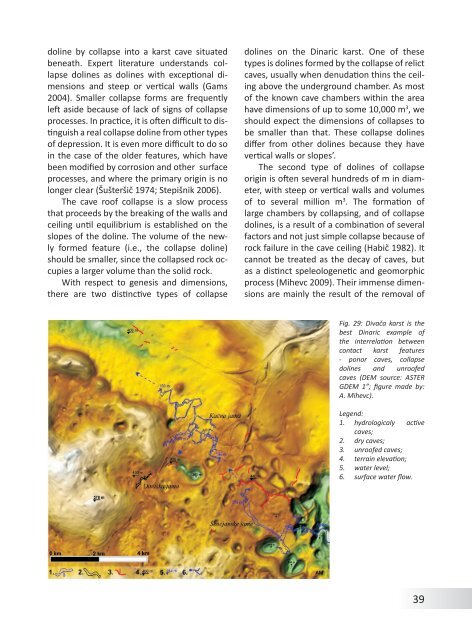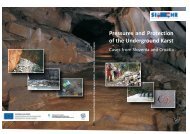Case Studies from the Dinaric Karst of Slovenia
Case Studies from the Dinaric Karst of Slovenia
Case Studies from the Dinaric Karst of Slovenia
You also want an ePaper? Increase the reach of your titles
YUMPU automatically turns print PDFs into web optimized ePapers that Google loves.
doline by collapse into a karst cave situatedbeneath. Expert literature understands collapsedolines as dolines with exceptional dimensionsand steep or vertical walls (Gams2004). Smaller collapse forms are frequentlyleft aside because <strong>of</strong> lack <strong>of</strong> signs <strong>of</strong> collapseprocesses. In practice, it is <strong>of</strong>ten difficult to distinguisha real collapse doline <strong>from</strong> o<strong>the</strong>r types<strong>of</strong> depression. It is even more difficult to do soin <strong>the</strong> case <strong>of</strong> <strong>the</strong> older features, which havebeen modified by corrosion and o<strong>the</strong>r surfaceprocesses, and where <strong>the</strong> primary origin is nolonger clear (Šušteršič 1974; Stepišnik 2006).The cave ro<strong>of</strong> collapse is a slow processthat proceeds by <strong>the</strong> breaking <strong>of</strong> <strong>the</strong> walls andceiling until equilibrium is established on <strong>the</strong>slopes <strong>of</strong> <strong>the</strong> doline. The volume <strong>of</strong> <strong>the</strong> newlyformed feature (i.e., <strong>the</strong> collapse doline)should be smaller, since <strong>the</strong> collapsed rock occupiesa larger volume than <strong>the</strong> solid rock.With respect to genesis and dimensions,<strong>the</strong>re are two distinctive types <strong>of</strong> collapsedolines on <strong>the</strong> <strong>Dinaric</strong> karst. One <strong>of</strong> <strong>the</strong>setypes is dolines formed by <strong>the</strong> collapse <strong>of</strong> relictcaves, usually when denudation thins <strong>the</strong> ceilingabove <strong>the</strong> underground chamber. As most<strong>of</strong> <strong>the</strong> known cave chambers within <strong>the</strong> areahave dimensions <strong>of</strong> up to some 10,000 m 3 , weshould expect <strong>the</strong> dimensions <strong>of</strong> collapses tobe smaller than that. These collapse dolinesdiffer <strong>from</strong> o<strong>the</strong>r dolines because <strong>the</strong>y havevertical walls or slopes’.The second type <strong>of</strong> dolines <strong>of</strong> collapseorigin is <strong>of</strong>ten several hundreds <strong>of</strong> m in diameter,with steep or vertical walls and volumes<strong>of</strong> to several million m 3 . The formation <strong>of</strong>large chambers by collapsing, and <strong>of</strong> collapsedolines, is a result <strong>of</strong> a combination <strong>of</strong> severalfactors and not just simple collapse because <strong>of</strong>rock failure in <strong>the</strong> cave ceiling (Habič 1982). Itcannot be treated as <strong>the</strong> decay <strong>of</strong> caves, butas a distinct speleologenetic and geomorphicprocess (Mihevc 2009). Their immense dimensionsare mainly <strong>the</strong> result <strong>of</strong> <strong>the</strong> removal <strong>of</strong>Fig. 29: Divača karst is <strong>the</strong>best <strong>Dinaric</strong> example <strong>of</strong><strong>the</strong> interrelation betweencontact karst features- ponor caves, collapsedolines and unro<strong>of</strong>edcaves (DEM source: ASTERGDEM 1”; figure made by:A. Mihevc).Legend:1. hydrologicaly activecaves;2. dry caves;3. unro<strong>of</strong>ed caves;4. terrain elevation;5. water level;6. surface water flow.39










